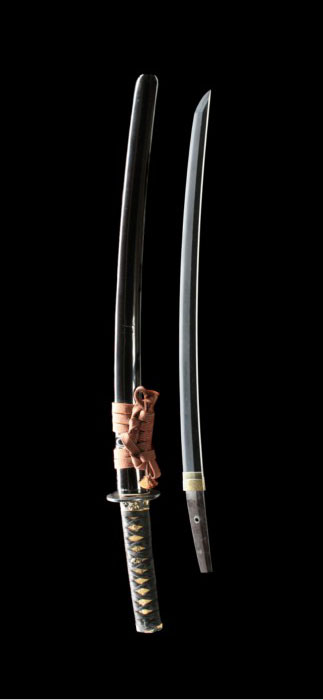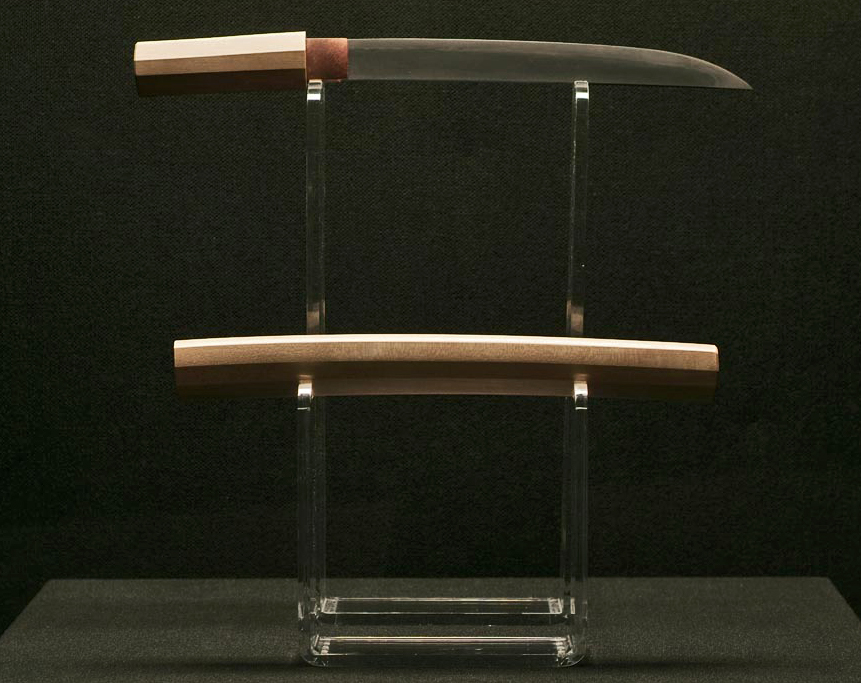

During the Nara period of Japanese history, between 700 AD and 900 AD, there was a transition from having an imperial army comprised of conscripted men to relying more and more on specialized forces comprised of men who made war their trade. These were the first samurai, who began as mercenary forces hired by the imperial court. As time went on, samurai banded into clans that served as local armies in service of the Japanese empire. During the Kamakura period, between 1192 and 1467, the samurai took control of the imperial court and established the Shogunate rule, a government based on the rule a Shogun - the high general. Raised from simple soldiers to political figures, the samurai shaped Japan's military history up until their abolishment in the nineteenth century. Up until the peaceful times of the Tokugawa period of the seventeenth century, war had been a central theme of Japan, forcing sword smiths and blade smiths to create stronger and better weapons as time went on.
The main weapons used by military forces at the time were bows and spears, useed by the samurai and common soldiers respectively. During the fifteenth century, however, the samurai transitioned to using spear-like lances as well. Long swords, known as katana, were primarily used by the samurai, but short swords, known as wakizashi, and knives, known as tanto, were used by almost everyone. The katana are famous world wide for their unique balance between deadly efficiency and beauty. Their blades are sharp and flexible and can be used both as slashing and stabbing weapons, and their handles and sheaths are often wrapped and lacquared with beautiful designs.
Japanese armors used by the samurai were made from small scales and were very flexible. They could be folded and collapsed for storage and transportation. They were also easily repaired after damage was done to them. They are also considered to be among the most beautiful and colorful armors in the world. They were very intricate in their design and artists would usually help in their making by applying lacquer and producing different braiding patterns.
BLADES |
|
|
The katana's blade is between two and three feet with a single sharp edge. The sword's curve enhances its slashing ability. The signature weapon of the samurai, the katana is worn edge up so that drawing and attacking can be combined in a single motion. The blade is made of a combination of different types of steel (high carbon hard steel on the edge, low carbon soft steel at the core and medium carbon steel in different arrangements), making it strong and agile. The handle is made of wood and wrapped with stringray skin and silk cord or leather strips. The fittings are made of precious metals - gold or silver. |
|
|
The wakizashi's blade is between one and two feet long. It too is curved to match the katana. The katana and wakizashi are worn together as a daisho (pair). Their curves therefore match for aesthetic reasons. The wakizashi was used primarily by samurai but could be used by merchants or other individuals as well. The blade of the wakizashi is also made of steel, but usually just one or two types of it. Since it is so small there is not much benefit to using many different steels. The handle usually matches the katana's. |
|
|
The tanto is a straight bladed knife with a blade up to one foot long. The tanto sometimes accompanied the katana in place of the wakizashi, but was also sometimes used alongside both longer blades. Since it is small, sharp and tough, the tanto was used as a stabbing weapon, often to finish a fight with a deadly blow. The tanto's blade is only made of high carbon steel. The handle is either plain wood or matches the katana and wakizashi it accompanies. |
|
BOWS |
|
|
The medieval Japanese bow was assymetrical and about six feet long. The bow was actually the primary weapon of the samurai up to the fourteenth century, meant to be drawn from horseback by elite mounted samurai units, who would lift it above their heads and lower it while drawing. Samurai would often train with the bow through competitions and difficult challanges. The Japanese bow was made of lighter wood than its European counterpart, which accounts for its size. The string is hemp. |
|
SPEARS |
|
|
The yari is a lance-like spear at least eight feet long, with later iterations going up to eighteen feet. The yari replaced the bow as the main weapon of the samurai during the fourteenth century, since it was a more versatile weapon both offensively and defensively. Its length changed based on the lengths of the spears used by foot soldiers that were set to counter the mounted samurai charges. The yari spear is basically a short sword blade mounted on a long wood pole. |
|
ARMORS |
|
 Ornate kabuto from the Glenbow Museum collection |
The kabuto helmet was also used by the samurai. Meant to impress rather than protect, it was often decorated with colorful scales, wooden horns and paint. If a face plate was present, it was shaped as a frightful, distorted face that could demoralize the enemy and be easily identified. The kabuto's purpose was to make a samurai identifiable to his generals, so that he would be promoted for good work. |
|
Name: O yoroi. Worn by the samurai and upperclass Japanese officials in the Gempei wars (1180-1185) and against the invasion of the Mongols (1271-1281). Suited for mounted archers and cavalry men. Made of thousands of small scales (kozanes) made of iron or leather laced together with braided silk or leather cords. Very heavy and box-like. Known for its beautiful, unique design. Materials used: Silk, leather, iron, copper, lacquer, natural dyes. |
|
 Ogawa (2009) Art of the Samurai: Japanese Arms and Armor, 1156 - 1868 |
Name: Do maru. Used in the Gempei wars by foot soldiers. Do maru gained popularity in the fourteenth century when more battles were fought on foot or in urban environments. A Lighter armor with a simpler design, the do maru is less bulky and more form fitting than the O Yoroi. The skirt part (kuzazuri) is divided into more sections to allow for greater freedom of movement. It is also made with fewer scales than the o yoroi and is less colorful. |
|
The shoulder guards, known as sode, were used both with the o yoroi and do maru armors, but were not always present. The sode were made of the same lamellar scales that the reset of the armor was made of, but was kept separate from the main body of the armor to allow for greater mobility. The sode grew smaller over time as combat moved to more urban, closely confined areas. |
|


Integrative Materials Design Center - Worcester Polytechnic Institute






